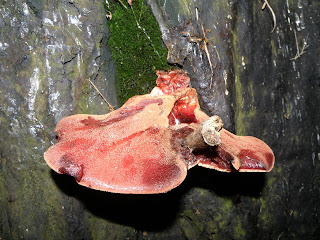I am also in debt to give some insight into the experiment I have been busy at the University in the past months: cultivation of two strains of king oyster (Pleurotus eryngii var. eryngii and var. ferulae) and shiitake (Lentinula edodes) on sterilized spent coffee grounds and straw mix.
In the meanwhile, however, I share some of the photos I made during the short exploration of Dartington Hill in Devon, near Totnes. This is a transition village, with many interesting agroforestry, organic and sustainable initiatives, with a strong focus on community empowerment and letting go over-consumption and dependency on non renewable resources.
The surrounding is beautiful, with huge, ancient chestnut, oak, and beech trees. Dartington Hill is an especially splendid and taken care part of the area. I have found mostly brackets, only couple of mycorrhizals and none of the saprobes. And lots of lichen :).
Some of the flora and lichen:
As per the mycorrhizal mushrooms, I have found a Russula, probably a to-be Amanita and a Xerocomus. Period.
In the trunk of one of the amazing hundred years old Taxus trees in the old celtic cemetery I have found a growing white bracket:

Back in Totnes yet, in the small castle park next to the ruins of the castle, I have bumped with all likeliness into couple of Ganoderma applanatum in the trunk of a HUGE oak tree:
Next to it, as nearly best present of the day stood an old beech trunk, harboring some nice Laetiporus sulphureus or chicken of the woods:
In the evening in Dartington Hall, I have been gifted with the nicest surprise of the day: Fistulina hepatica or beaf-steak polypore on a row of chestnut (Castanea sativa) trees:
Finding this fungi has been like a saint grail to me in the past 2 years, so unexpectedly running into it made my day big time :).
















































